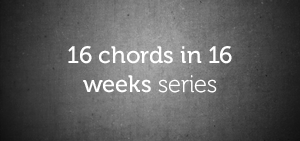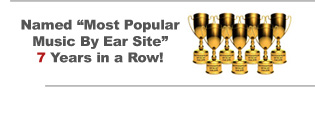If you want to know why augmented triads are not common, you’re on the right page.
Unlike major and minor triads, augmented triads are rarely used. This is not just for beginners; intermediate and advanced players too will agree to how less frequent the harmony of the augmented triad is.
Depending on the genre of music you’re playing, it’s possible to play for 1 year, 3, years, 7 years, 20 years, or a lifetime without playing an augmented triad. Trust me!
Submission: Advanced students are aware that the augmented triad can be used as an upper-structure to form other chords, but the reference to the augmented triad in this lesson is as a unique chord (and not an upper-structure).
You’ll find out the reason why the augmented triad is rare. Read on!
A Breakdown Of Scale Degree Chords In The Major Key
In the major key, there are seven unique tones. The key of C major (our reference):
…has seven unique tones:
C, D, E, F, G, A, and B
The chords that can be formed on each of the tones using the tones of the C major scale are referred to as scale degree chords.
The 1-Chord (a major triad)
Starting from the first tone of the C major scale:
…which is C:
…a scale degree chord can be formed in third intervals:
A third from C is E:
…and another third from E is G:
Altogether, we have C, E, and G:
…which is (for all intents an purposes) the C major triad.
The C major triad:
…which consists of C, E, and G (which are all tones of the C major scale) is a scale-degree chord in the key of C major and due to the position of C as tone number 1 in the C major scale, the C major triad is also know as the 1-chord in the key of C major.
The 2-Chord (a minor triad)
Starting from the second tone of the scale (D):
…the D minor triad is formed by stacking D, F, and A together:
…and due to the position of D as tone number 2 in the C major scale, the D minor triad is also know as the 2-chord in the key of C major.
The 3-Chord (a minor triad)
Starting from the third tone of the scale (E):
…the E minor triad is formed by stacking E, G, and B together:
…and due to the position of E as tone number 3 in the C major scale, the E minor triad is also know as the 3-chord in the key of C major.
Attention: To learn more about this, I recommend our 500+ page course: The “Official Guide To Piano Playing.” Click here for more information.
The 4-Chord (a major triad)
Starting from the fourth tone of the scale (F):
…the F major triad is formed by stacking F, A, and C together:
…and due to the position of F as tone number 4 in the C major scale, the F major triad is also know as the 4-chord in the key of C major.
The 5-Chord (a major triad)
Starting from the fifth tone of the scale (G):
…the G major triad is formed by stacking G, B, and D together:
…and due to the position of G as tone number 5 in the C major scale, the G major triad is also know as the 5-chord in the key of C major.
The 6-Chord (a minor triad)
Starting from the sixth tone of the scale (A):
…the A minor triad is formed by stacking A, C, and E together:
…and due to the position of A as tone number 6 in the C major scale, the A minor triad is also know as the 6-chord in the key of C major.
The 7-Chord (a diminished triad)
Starting from the seventh tone of the scale (B):
…the B diminished triad is formed by stacking B, D, and F together:
…and due to the position of B as tone number 7 in the C major scale, the B diminished triad is also know as the 7-chord in the key of C major.
Chord Qualities In The Major Key
From the breakdown of the scale degree chords in the major key, we derived the following chord qualities:
The major quality
The minor quality
The diminished quality
Let’s take a closer look at these chord qualities before we proceed.
Major quality chords are on the first, fourth, and fifth tones of the major scale. Consequently, the 1-chord, 4-chord, and 5-chord have the major quality.
Minor quality chords are on the second , third, and sixth tones of the major scale. Therefore, the 2-chord, 3-chord, and 6-chord have the minor quality.
The diminished quality chord is on the seventh tone of the major scale. This explains why the 7-chord, has a the diminished quality.
“So, Where Is The Augmented Triad In The Major Key?”
The major triad (the 1-chord and 4-chord), the minor triad (the 2-chord, 3-chord, and 6-chord), and diminished triad (the 7-chord) are all associated with the major key.
From our breakdown, we only encountered three triad qualities: the major, minor, and diminished triads. The augmented triad is NOT one of the triad qualities you can find in the major key.
This explains why augmented triads are not commonly used.
Attention: To learn more about this, I recommend our 500+ page course: The “Official Guide To Piano Playing.” Click here for more information.
Final Words
This is just the beginning of our study on the augmented triad. In a subsequent lesson, we’ll be looking at the origin of the augmented triad in tonal music.
Keep up the great work!
Chuku Onyemachi
Latest posts by Chuku Onyemachi (see all)
- The Formation Of Diminished Seventh Chords Used To Be Challenging Until I Did This
- How To Form Seventh Chords In Two Shakes Of A Dog’s Tail Using Third Intervals And The Circle Of Fifths Chart
- I Played The 13sus4 Chord And This Happened…
- How To Build Seventh Chords Like An Architect Using “Foundation And Structure” Concept
- This 4-Week Plan Will Help You Master All The Major Scales







Comments on this entry are closed.